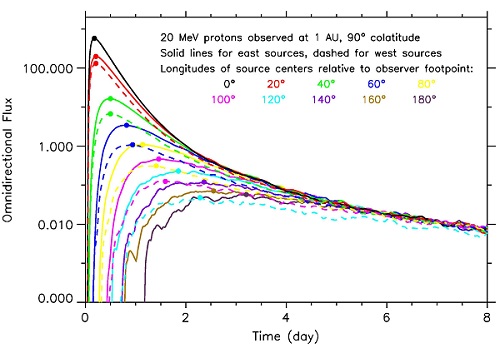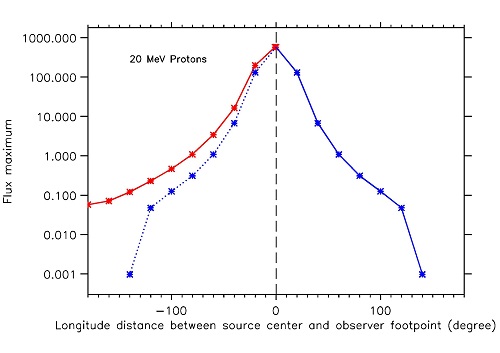Solar energetic particles (SEPs), which are charged energetic particles occasionally emitted by the Sun, endanger the health of astronauts working in space and damage electronic components on satellites, and so they have become a very important aspect affecting the solar-terrestrial space environment and space weather. In addition, SEPs observed in the interplanetary magnetic field provide fundamental information regarding the acceleration mechanisms and transport processes of charged energetic particles. The subject of SEPs has become a focus of space physics, astrophysics, and plasma physics.
Recently, Associate Professor HE Hongqing and Professor WAN Weixing numerically investigated the transport processes and longitudinal distribution of SEPs in the heliosphere. They found that there exists an east–west longitudinal asymmetry in the SEP intensities, such that, with the same longitude separations between the solar sources and the magnetic footpoint of the observer, the fluxes of SEP events originating from solar sources located on the eastern side of the nominal magnetic footpoint of the observer are systematically larger than those of the SEP events originating from sources located on the western side. In addition, they also found that the peak fluxes of the SEP events originating from solar sources located on the eastern side of the observer footpoint are systematically larger than those of the SEP events originating from sources located on the western side. For the formation mechanism of this interesting phenomenon, they concluded that the longitudinally asymmetric distribution of SEPs results from the east–west azimuthal asymmetry in the topology of the Parker interplanetary magnetic field as well as the effects of perpendicular diffusion on the transport processes of SEPs in the heliosphere.
Generally, the probability of SEP events being observed by spacecraft in the interplanetary space and near Earth's orbit is proportional to the particle flux intensity of the events. Consequently, SEP events originating from solar sources located at the eastern relative longitudes are more likely to be detected and recorded by spacecraft. The discoveries presented in this work will therefore be valuable for understanding the solar-terrestrial relations and useful in space weather forecasting.
These results have been recently published in The Astrophysical Journal Supplement Series (He & Wan, Numerical Study of the Longitudinally Asymmetric Distribution of Solar Energetic Particles in the Heliosphere. The Astrophysical Journal Supplement Series, 2015, 218, 17, doi:10.1088/0067-0049/218/2/17). (Article Website)

Figure 1. With the same longitude separations between the magnetic field footpoint of the observer and solar sources, the SEP fluxes from solar sources located on the eastern side (solid lines) of the observer footpoint are larger than those from solar sources located on the western side (dashed lines).

Figure 2. With the same longitude separations between the solar sources and the magnetic footpoint of the observer, the peak fluxes of the SEP events originating from solar sources located on the eastern (left) side of the observer footpoint are systematically larger than those of the SEP events originating from sources located on the western (right) side.

 Print
Print Close
Close

